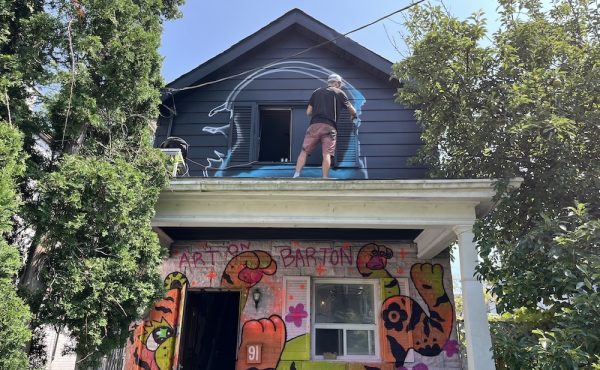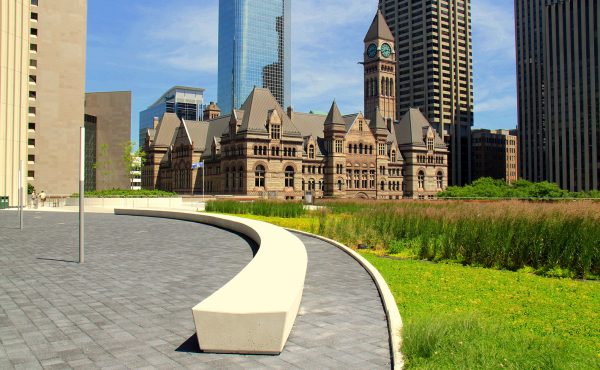
Cross-posted from No Mean City, Alex’s personal blog on architecture
![]()
A couple of weeks ago, an unusual box dropped in on a corner in Lower Manhattan. It’s basically a shipping container – but with windows, wrapped in cedar, and containing a tightly designed modernist interior. Co-designed by the Torontonian Jason Halter, it’s a prefab house, and it’s both handsome and cheap: prices start from a remarkable $40,000 U.S. for 320 square feet, delivered to a port near you. People noticed. A famous movie producer dropped by, said he’d like to put one on his rooftop, and mentioned that his pal Julian Schnabel might want to be involved.
Yes, the company, Meka, is working with a sexy concept. Prefab housing has been one of the great dreams of modern architecture. The idea: build a house in a factory, ship it to a site and hook it up. Voila! A finished contemporary home without the complexities, imperfections – and waste – of regular construction.

I haven’t seen the Meka product in person, but reviews are very good, and Halter is a talented designer. The photos suggest a simple but well-detailed building – with bamboo flooring, bright orange cabinets and a few exposed sections of corrugated steel – that would make a very nice one-person cottage or sleeping cabin.
Combined or stacked up in various combinations, they look equally handsome. There is usually a catch with such schemes, though. Building in North America is expensive. Shipping a house is expensive and complex. Selling enough units to make a business work is tough. But Halter and company – architect Christos Marcopoulous designed their houses with Halter, and his partners are entrepreneur Michael De Jong and manufacturer Stephen Do – claim to have solved them all by outsourcing the production to Ningbo, China.
Halter, an alumnus of Bruce Mau Design who now works with Giannone Petricone Architects, says the ambition is clear: Cheap, attractive housing, available globally, and with a green conscience.
The project was born out of conversations between him and his old friend De Jong. “It was based on not an aesthetic or philosophical design position, but: Can we supply affordable housing by manufacturing in China?” The advantages: cheap production, and also an attack on one of the basic logistical problems, how to ship an entire house around the world. “Making it in a place that’s a major outbound port of the world – that makes shipping a lot easier.”
An entire 400-square-foot house can be built within a shipping container, and packed up to go on a freighter. On the site – anywhere that a truck and a crane can reach – clients connect the services, and away they go. (Assuming they’ve got planning permission and a foundation in place.)
This has real environmental advantages. Meka is building with recycled materials; and prefab should be inherently green. Along with putting the steel containers to a second use, this form of construction usually creates much less waste than a conventional stick-build; building projects generate an enrmous proportion of North America’s trash.
Right now Halter says the primary market seems to be second homes in North America, but he’s excited about prospects in the Caribbean and in parts of the American Midwest where construction is tough. Halter and company are now developing larger modules, with two or three containers sealed together – and they’re consulting with building code experts about how to make the houses ready for electrical service in any country.
So it this for real? Other entrepreneurs are already in this market, but Meka’s promised price and quality has been attracting plenty of attention, from New York media (and Halter says online too, with 10,000 hits to its website in two weeks). The film producer, Jon Kilik, is still talking about buying it. Halter says other orders and more production are in the works.
And yes, that house in Manhattan has a buyer – in Canada. You want one, you’ll have to order your own.










11 comments
Very interesting approach to building housing, and very nice quality of finish. I wonder how well they can be stacked? Putting up a low-rise apartment building from these in a matter of days could be quite the accomplishment.
But I’m also curious about the quality of insulation. A big metal box has a lot of surface area to lose/gain heat. And the design, while very open inside, doesn’t look to have any space for air conditioning or heating or air circulation in general.
Wait, the advantage is cheap production? What are the other costs?
I count 2 unnecessary Ocean voyages (there & back), unspecified disposal of toxic wood interiors (used to mitigate spread of invasive species through globalization), potential humaine labour issues, etc.
In the end we get either one-off ‘installations’ that ignore the character of existing neighbourhoods or whole developments that look like bland boxes stacked at most 2 high. Nothing is gained other than future regrets.
It’s not even a new concept. Look at ecopods and zigloo, both have been doing this here in Canada. Others elsewhere.
Aside from marketing, what’s the difference between this and trailers/manufactured homes?
@M, I think most new developments in Toronto are already bland boxes 😉 Good point re. the ocean voyages, but how much pollution is created by scores of work vehicles delivering the odd bit of structure for a conventional house here and there, not to mention carting off the off-cuts etc.? Apples shipped in fresh from New Zealand can actually have a smaller CO2 footprint that those stored in cooled warehouses here. And water-based transport is actually quite efficient. I’d not dismiss this idea without a proper craddle-to-grave analysis. Could the flat roofs of these container houses support plantings? That would be an eco-plus over conventional tar-paper shingles, and might help with John Duncan’s concern too.
The area is small enough that air conditioning and heating can be from a single point or unit. Heavy guage steel would probably permit stacking of 8 stories. Insulation should probably be external.
I like it
lets get them for artist studios and students and people in between.
I want one too.
Could be good for laneway housing.
i think your decision is correct but everybody does not agree with you. i think that’s not a matter for you. keep it up.
Like like like.
Laneway housing has been a reality in Vancouver for some time, but Toronto planners don’t want to take the concept seriously. Lots of opportunity!
I agree, Toronto needs to stop obstructing those who want to build laneway houses. The many examples we have already provide evidence that it can work. Our planners need to embrace it. Hopefully, Rob Ford can help cut the red tape and make it happen.
In fact, laneway housing in Toronto is an ancient concept that we need to resurrect. Victorian Toronto built some charming examples:
http://maps.google.com/maps?hl=en&q=Ashby+Place,+toronto&ie=UTF8&hq=&hnear=Ashby+Pl,+Toronto,+Toronto+Division,+Ontario+M5A+3E3,+Canada&ll=43.655445,-79.357005&spn=0.006544,0.014462&z=17&layer=c&cbll=43.656247,-79.357919&panoid=hbcg6Q42ELm35gQ-vrd-QA&cbp=12,9.72,,0,2.06
On the one hand laneway housing is promoted in Toronto through programs encouraging the creative plans of laneway housing, but the meat and potatoes of making these viable projects come to fruition, never get to the table – it is a very frustrating situation.